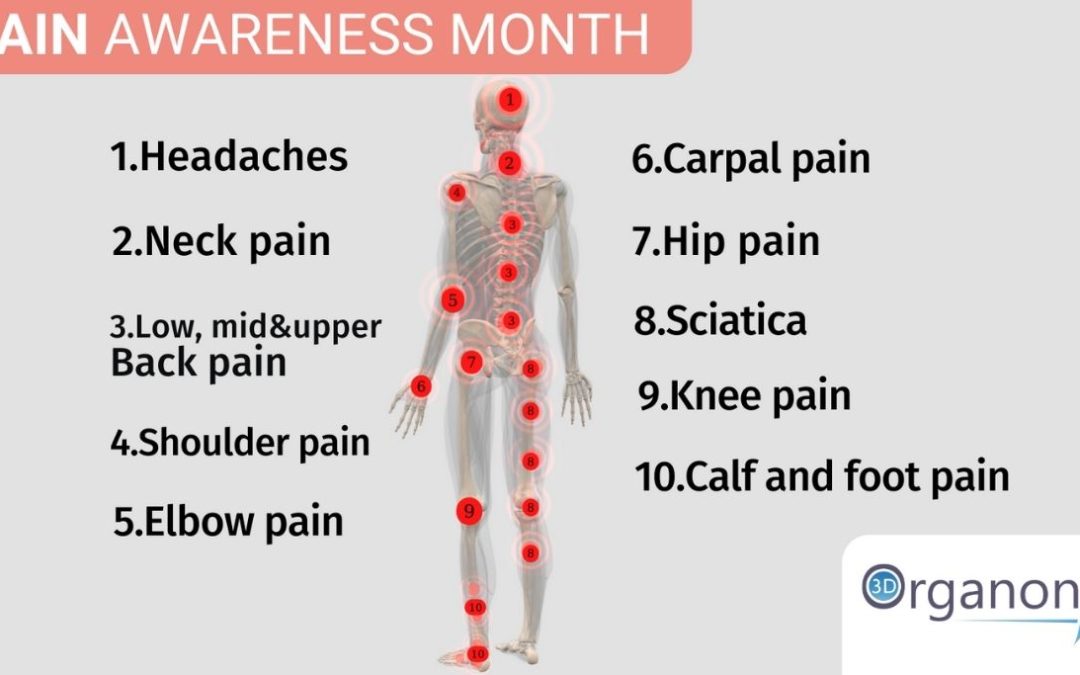September is declared Pain Awareness Month by The World Health Assembly (WHA) a subsection of the World Health Organization (WHO). A month to put focus on better understanding the underlying causes of pain, which can help improve treatments and alleviate suffering.
What is the definition of pain?
Pain is an unpleasant sensory and emotional experience associated with, or resembling that associated with actual or potential tissue damage. It is a distressing feeling often caused by intense or damaging stimuli. Pain motivates the individual to withdraw from damaging situations, protect a damaged body part while it heals, and avoid similar experiences in the future
The brain and the nerves inside the spine (the spinal nerves) make up the central nervous system. The spinal nerves carry messages from the body to the brain to tell it what’s going on. The brain acts like a control center working out from these messages if it needs to do anything. It’s sometimes easier to think of how the messages and the brain combine together to form an alarm system. It’s the brain’s interpretation of this information from the alarm system that results in the feeling of pain. However, sometimes the brain’s interpretation of these signals isn’t accurate.
Pain Pathways
Pain due to injury begins at special pain receptors scattered throughout the body. These pain receptors transmit signals as electrical impulses along nerves to the spinal cord and then upward to the brain. Sometimes the signal evokes a reflex response. In these cases, when the signal reaches the spinal cord, a signal is immediately sent back along motor nerves to the original site of the pain, triggering the muscles to contract without involving the brain. Only when the brain processes the signal and interprets it as pain do people become aware of the pain.
Chronic pain
Chronic pain is a debilitating condition that affects many people. The statistics for chronic pain are astounding, and you should know them if you or someone close to you suffers from this ailment.
Pain Statistics
- An estimated 1 in 5 people in the world population experiences some form of chronic pain.
- In the United States alone, 50 million people suffer from chronic daily pain.
- 6 million have high-impact chronic pain (chronic pain that frequently limits life or work activities)
- 10% of people in the world experience chronic pain
- Chronic pain victims get 42 fewer minutes of sleep per day
The most common types of chronic pain include:
- musculoskeletal pain (e.g., chronic low back pain, neck pain, arthritis pain)
- neuropathic pain (e.g., peripheral neuropathy, trigeminal neuralgia)
- functional pain syndromes (e.g., fibromyalgia, chronic migraine, chronic pelvic pain)
- chronic pain after surgery
- complex regional pain syndrome
- cancer pain
Explaining pain with 3D Organon
3D Organon is a valuable tool for understanding pain. The Pain effect toolkit helps the user place colored glowing spheres at custom locations onto anatomical structures and organs. These effects are useful in demonstrating pain points or regions that demand learners? attention during teaching. Clinicians will, also, favor this repertoire of resources in patient education sessions.
Join 3D Organon now: www.3dorganon.com
References:
https://www.msdmanuals.com/home/brain,-spinal-cord,-and-nerve-disorders/pain/treatment-of-pain
https://anest.ufl.edu/2020/09/08/september-is-pain-awareness-month/
https://europeanpainfederation.eu/pain-awareness-month-2022/
https://www.nhsinform.scot/illnesses-and-conditions/brain-nerves-and-spinal-cord/chronic-pain
For the latest news, follow 3D Organon on social media.

